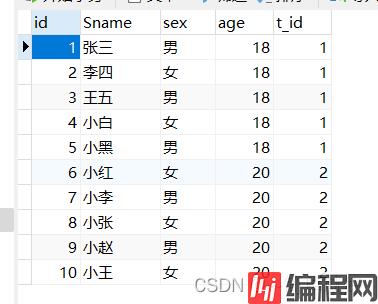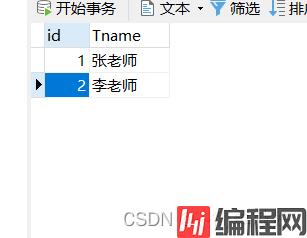Python 官方文档:入门教程 => 点击学习
目录一、关联映射二、一对一多对一的关系1.第一种形式-连表查询2.第二种形式-分步查询三、一对多第一种形式按照结果嵌套处理第二种形式按照查询嵌套处理一、关联映射 举例关系说明 数据库
举例关系说明
数据库创建表,student,teacher


关系说明:
查询学生信息及其对应的教师信息
学生实体:用对象来存储教师信息,因为一个学生对应一个教师对象
public class Student {
private Integer id;
private String Sname;
private String sex;
private Integer age;
private Integer t_id;
//这个是重点
private Teacher teacher;
}
教师实体:
public class Teacher {
private Integer id;
private String Tname;
}
SELECT student.id,student.name,teacher.name FROM student LEFT JOIN teacher on student.t_id = teacher.id
mybatis多表联查查询语句:(嵌套其他实体对象)
对于特殊数据:
<!-- 按照结果嵌套处理-->
<select id="getStudent1" resultMap="StudentTeacher1">
SELECT student.id,student.Sname,teacher.Tname FROM student LEFT JOIN teacher on student.t_id = teacher.id
</select>
<resultMap id="StudentTeacher1" type="com.qcby.entity.Student">
<result property="id" column="id"/>
<result property="Sname" column="Sname"/>
<result property="sex" column="sex"/>
<result property="age" column="age"/>
<result property="t_id" column="t_id"/>
<!-- 复杂的属性我们需要单独去处理 对象:association 集合:collection -->
<!-- property="teacher" student类当中的关联字段 -->
<!-- javaType="com.javen.model.Teacher" 为复杂属性设置类类型-->
<association property="teacher" javaType="com.qcby.entity.Teacher">
<result property="id" column="id"/>
<result property="Tname" column="Tname"/>
</association>
</resultMap>
数据库查询sql:
SELECT s.id,s.Sname,t.Tname FROM student s,teacher t where s.t_id = t.idmybatis分布查询查询语句:
<select id = "getStudent" resultMap="StudentTeacher">
select * from student;
</select>
<!--结果映射集-->
<resultMap id="StudentTeacher" type="com.qcby.entity.Student">
<result property="id" column="id"/>
<result property="Sname" column="Sname"/>
<result property="sex" column="sex"/>
<result property="age" column="age"/>
<result property="t_id" column="t_id"/>
<!-- select="getTeacher" :调用下一个查询语句 -->
<!-- column="t_id" 两个表的关联字段-->
<association property="teacher" column="t_id" javaType="com.qcby.entity.Teacher" select="getTeacher"/>
</resultMap>
<select id="getTeacher" resultType="com.qcby.entity.Teacher">
select * from teacher where id = #{t_id}; <!-- #{id}; 可以写任何东西,因为会自动匹配 t_id -->
</select>查询教师对应的学生信息
设立教师实体:用集合来存储对应的学生信息,因为一个教师对应多个学生
public class Teacher {
private Integer id;
private String Tname;
//这个一定要有
private List<Student> students;
}
mybatis查询语句:
<!--按照结果进行查询-->
<select id="getTeacher" resultMap="TeacherStudent">
SELECT teacher.id,teacher.Tname,student.Sname FROM teacher
LEFT JOIN student on student.t_id = teacher.id
</select>
<resultMap id="TeacherStudent" type="com.qcby.entity.Teacher">
<result property="id" column="id"/>
<result property="Tname" column="Tname"/>
<!-- 复杂的属性我么需要单独去处理 对象:association 集合:collection
在集合中的泛型信息,我们使用ofType获取
-->
<collection property="students" ofType="com.qcby.entity.Student">
<!-- 查询什么写什么 -->
<result property="Sname" column="Sname"/>
</collection>
</resultMap>
mybatis查询语句: 对于特殊字段集合采用分布查询的方式,特殊字段特殊处理:< collection property=“students” column=“t_id”
ofType=“com.qcby.entity.Student” select=“getStudentByTeacherId” />,getStudentByTeacherId一个新的查询语句
<!--按照查询嵌套处理:分布查询-->
<select id="getTeacher" resultMap="TeacherStudent2">
select * from teacher
</select>
<resultMap id="TeacherStudent2" type="com.qcby.entity.Teacher">
<!--column="t_id" 传值-->
<collection property="students" column="t_id"
ofType="com.qcby.entity.Student" select="getStudentByTeacherId" /> <!--实现分布查询-->
</resultMap>
<select id="getStudentByTeacherId" resultType="com.qcby.entity.Student">
select * from student where id = #{t_id}
</select到此这篇关于Mybatis关联映射举例详解的文章就介绍到这了,更多相关Mybatis关联映射内容请搜索编程网以前的文章或继续浏览下面的相关文章希望大家以后多多支持编程网!
--结束END--
本文标题: Mybatis关联映射举例详解
本文链接: https://www.lsjlt.com/news/165641.html(转载时请注明来源链接)
有问题或投稿请发送至: 邮箱/279061341@qq.com QQ/279061341
下载Word文档到电脑,方便收藏和打印~
2024-03-01
2024-03-01
2024-03-01
2024-02-29
2024-02-29
2024-02-29
2024-02-29
2024-02-29
2024-02-29
2024-02-29
回答
回答
回答
回答
回答
回答
回答
回答
回答
回答
0